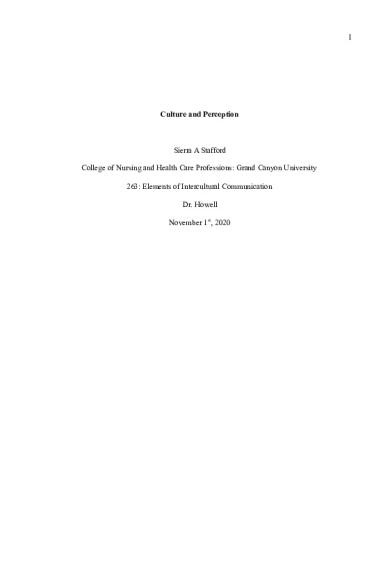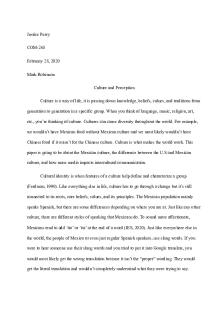Culture and Perception Essay PDF

| Title | Culture and Perception Essay |
|---|---|
| Course | Elements of Intercultural Communication |
| Institution | Grand Canyon University |
| Pages | 6 |
| File Size | 100.5 KB |
| File Type | |
| Total Downloads | 81 |
| Total Views | 143 |
Summary
In 1,000-1,250 words, complete the following:
Describe the cultural identity of a particular cultural group and how the culture’s identity is represented symbolically in the culture’s communication patterns, values, language, architecture, pastimes, art, relational roles, societal syste...
Description
1
Culture and Perception
Sierra A Stafford College of Nursing and Health Care Professions: Grand Canyon University 263: Elements of Intercultural Communication Dr. Howell November 1st, 2020
2 Culture and Perception Culture and perception are how one’s culture affects the way they view the world. Culture is in all forms of life such as religion, food, art etc. It can be referred to how individuals are shaped by their environment as well as social and cultural factors such as nationality, race and gender. Thai culture can be represented symbolically, through many ways of communication such as values, language, tradition, as well as the media. Cultural Identity Thailand culture is represented by not only by different ways of communication, but by their respect of one another and their ways of living. Thailand culture can be represented symbolically by ways of communication like values. In Thai culture it is a duty to uphold “three main pillars of the country: the nation, the religion, and the monarchy” (Bangkok, 2014). Other values include: “Honesty, sacrifice, and patience with positive attitude for the interest of the public” (Bangkok, 2014). All these values have a common ground in comparison to other cultures as well. Language is also another form of how culture communication is represented. Language is an expression of culture, it has different meanings like values, beliefs, and customs, it can show tradition and ways of your own life. In Thailand, the language spoken most frequently is Thai, but English is a popular second language to learn. Tradition is another way of presenting cultural identity. In Thailand, many forms of tradition are formed, as well as cultural ceremonies and religion. One of the most important influences on Thai culture has been Buddhism. Their religion is much different than other cultures, as Thailand is known for their type of religion. There are multiple temples of beautiful architecture that are in the middle of the large cities for people to go to. Which shows how
3 important religion is to them. For example, Wat Phra Kaew, which was built in 1782 which was originally built for living quarters from monks. The structure has many different and special carvings and markings on it which shows their own way of culture even more (Iverson, 2017). Tradition is a huge custom of the country. Many cultural customs and traditions vary from culture to culture as if you visit a specific country, it is best to be respectful in the way you act or dress. Different customs in Thailand include personal space as you should not pat an adult or child on the head and the same goes for touching and pointing at people with your feet. Other customs include Buddhist monks, as within their religion strictly dictates that they must avoid any temptation of women, therefore giving respectful distance from women. Their monarchy and pride are very important to Thai culture, as if you show any way of disrespect towards any royalty, you can receive up to 15 years imprisonment (Gapyear, 2019). Lastly, the national symbol of Thailand, elephants. They are a huge part of Thai culture because they are portrayed as sacred animals, and are references to artwork, literature, and national emblems, specifically coming from the practice of Buddhism. Symbolic Representations in Media Culture is represented through media in different ways whether that be positively or negatively. Positive in a way that is has impacted social media in connecting so many people around the world. In which you can share your own opinions and pictures. Social media has also improved on international businesses, as the demand for online buying is increasing. In contrast, there are negatives. While social media can share any pictures, which may be inappropriate to cultures, it can make people change their points of view. This can make peoples perception change, whether that be political, religion or culture.
4 In different cultures and countries, media is dispersed very differently. For example, Thailand and how they are perceived on the media in their own country versus America and how they perceive and view their culture on media. “Digital culture refers to the knowledge, beliefs, and practices of people interacting on digital networks that may recreate tangible-world cultures or create new strains of cultural thought and practice native to digital networks” (Poepsel, pg.15, n.d). Digital culture in real terms can be a concept about how technology is involved and how people interact and how to think and communicate within a society and culture. In Thailand, one of their main symbolic representations is an elephant. Stated previously, the elephant represents their religion as it is a sacred and an important piece of Thailand’s culture. In recent months, Thailand’s own media channels have posted multiple news articles about how elephants are struggling and endangered because of COVID-19. By not having any tourist to help pay for food and such. Comparing to the U.S media, all the information is the same. While both these stories are very similar for both in their culture and out, not every single event or thing on the media is true, you must be culturally aware of your own perception of culture. Intercultural Communication in Mass Media Intercultural communication is a way for everyone to communicate with others whether that be from a different culture or country. There are multiple ways of communicating, such as verbal and nonverbal. The mass media can portray a stereotype on cultures that can make others think something that may not be true. According to the textbook, “American Indians comes from product packages, advertising, and mass media portrayals, what would you conclude about the physical, emotional, and intellectual characteristics of indigenous North Americans? Bloodthirsty savages? Children of nature? Indian princesses? Defilers of White virgins? These are a few of the
5 persistent stereotypes that appear in the mass media, particularly in advertising and as brands that features images and attributes of Native Americans” (Neuliep, pg. 105, para.6, 2017). While this is an example of Indian culture, it happens with multiple other cultures including Thailand culture as well. The impact of media especially today has greatly increased intercultural perceptions and interactions of one another by stereotypes and false cultural representation.
References
6
Bangkok Post. (2014). 12 Thai values stickers unveiled. Retrieved from https://www.bangkokpost.com/thailand/general/451521/12-thai-values-stickers-unveiled Bangkok Post. (2020). Hungry and in chains, Thailand’s tourist elephants face crisis. Retrieved from https://www.bangkokpost.com/world/1890195/hungry-and-in-chains-thailands-touristelephants-face-crisis Gapyear. (2019). Customs in Thailand. Retrieved from https://www.gapyear.com/south-eastasia/thailand/local-customs-thailand Iverson, K. Culture Trip (2017) A Brief History of Wat Phra Kaew in Bangkok. Retrieved from https://theculturetrip.com/asia/thailand/articles/a-brief-history-of-wat-phra-kaew-in-bangkok/ Neuliep, J. W. (2017). Intercultural communication: A contextual approach (7th ed.). Thousand Oaks, CA: Sage Publications. ISBN-13: 9781506315133 Poepsel, M. (n.d). Media, Society, Culture and You. Retrieved from http://solr.bccampus.ca:8001/bcc/file/8f2a750a-728d-496a-89c3-6f53dce9a783/1/Media-SocietyCulture-and-You-1539701744.pdf Sivasomboon, B., & Peck, G. (2020). Thai elephants out of work due to coronavirus, trudge home. Retrieved by https://apnews.com/article/0068ea45dd7af19ff2133d242e72a706...
Similar Free PDFs

Culture and perception essay
- 6 Pages

Culture and Perception Essay
- 6 Pages

Essay PLAN - FACE Perception
- 4 Pages

Culture essay rough draft
- 9 Pages

Perception
- 3 Pages

Perception and communication
- 3 Pages

Sensation and Perception
- 42 Pages

Exposure, Attention, and Perception
- 10 Pages

Music Culture Essay - Grade: A
- 2 Pages

Ant Essay 2- Chinese culture
- 7 Pages

PERCEPTION
- 10 Pages

Cancel Culture Essay - Grade: A
- 2 Pages
Popular Institutions
- Tinajero National High School - Annex
- Politeknik Caltex Riau
- Yokohama City University
- SGT University
- University of Al-Qadisiyah
- Divine Word College of Vigan
- Techniek College Rotterdam
- Universidade de Santiago
- Universiti Teknologi MARA Cawangan Johor Kampus Pasir Gudang
- Poltekkes Kemenkes Yogyakarta
- Baguio City National High School
- Colegio san marcos
- preparatoria uno
- Centro de Bachillerato Tecnológico Industrial y de Servicios No. 107
- Dalian Maritime University
- Quang Trung Secondary School
- Colegio Tecnológico en Informática
- Corporación Regional de Educación Superior
- Grupo CEDVA
- Dar Al Uloom University
- Centro de Estudios Preuniversitarios de la Universidad Nacional de Ingeniería
- 上智大学
- Aakash International School, Nuna Majara
- San Felipe Neri Catholic School
- Kang Chiao International School - New Taipei City
- Misamis Occidental National High School
- Institución Educativa Escuela Normal Juan Ladrilleros
- Kolehiyo ng Pantukan
- Batanes State College
- Instituto Continental
- Sekolah Menengah Kejuruan Kesehatan Kaltara (Tarakan)
- Colegio de La Inmaculada Concepcion - Cebu



